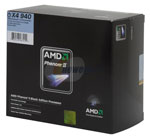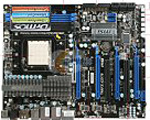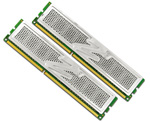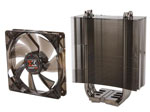AMD Performance Midrange
With Phenom II, an apology is no longer needed when putting together an AMD performance midrange system. While the Phenom was an honest competitor at the price points where AMD chose to compete, the poor overclocking of the AMD Phenom compared to Intel Core 2 Duo and Quad processors was always a nagging reality. Phenom II changes all that, and AMD in 45nm clothes is once again a screaming overclocker. We have reached 3.9-4.0GHz in internal Phenom II testing, which places the Phenom II squarely into Intel Core 2 overclocking territory. The days when AMD meant lots of overclocking headroom have finally returned - at least through the midrange CPUs.
| AMD Performance Midrange PC | ||
| Hardware | Component | Price |
| Processor | Phenom II x4 955 Black Edition (3.2GHzx4 125W 4x512KB L2, 6MB L3) | $200 |
| Cooling | Xigmatek HDT-S1283 120mm Rifle CPU Cooler - Retail (after $10 Rebate) | $27 |
| Motherboard | MSI 790FX-GD70 AM3 DDR3-2000+ | $170 |
| Video | MSI Radeon HD 4890 1GB OC Edition (After $30 Rebate) | $170 |
| Memory | OCZ Platinum AMD Edition 4GB (2 x 2GB) DDR3 1600 (PC3 14400) Low Voltage Model OCZ3P1600LVAMGK 7-7-7-24 | $87 |
| Hard Drive | Western Digital Caviar Black 1TB WD1001FALS | $95 |
| Optical Drive | LG BD/HD DVD 8X BD read/16x DVD read/write CH08LS10 - Retail | $130 |
| Audio | On-Board | $ - |
| Case | Cooler Master Storm Scout SGC-2000-KKN1-GP Mid-Tower | $100 |
| Power Supply | Corsair CMPSU-750TX 750w 80 PLUS Certified SLI/Crossfire Ready Core i7 Power (after $20 Rebate) | $100 |
| Base System Total | $1079 | |
| Display | ASUS VW266H Black 25.5" 2ms(GTG) HDMI Widescreen LCD Monitor (1920x1200) (after $30 Rebate) | $300 |
| Speakers | Logitech G51 155 watts RMS 5.1 Surround Sound Speakers - Retail | $120 |
| Input | Microsoft CA9-00001 Black PS/2 Standard Keyboard and Optical USB/PS2 Mouse - OEM | $16 |
| Operating System | Microsoft Vista Home Premium OEM | $99 |
| Complete System Bottom Line | $1614 | |
| SSD (Optional) | OCZ Vertex OCZSSD2-1VTX120G 2.5" 120GB SATA II MLC Internal Solid State Disk | $339 |
 |
The Phenom II 955 Black Edition at 3.2GHz x4 is the fastest of the currently shipping AMD Phenom II processors. Recently the Phenom II 955BE has been frequently on sale, as it is right now for just $199.95. That is a great price on the flagship Phenom II and it brings tremendous value to the AMD performance midrange system. The Phenom II is very similar in L2/L3 cache configuration to the Intel Core i7, but i7 is clearly the better performer and the fact it sells for more reflects that reality.
 |
We've paired the Phenom II 940 with the MSI 790FX-GD70 motherboard based on the 790FX chipset. While the 790FX is an older chipset than the 790X and 790GX, it still provides features like true dual x16 PCIe slots that are not available in the newer chipsets. Internal testing also shows performance is slightly better with the FX chipset than the newer chipsets, making this board an ideal match to the top 955BE Phenom II.
 |
Since the MSI supports dual-channel DDR3, the motherboard was populated with a 4GB kit of OCZ Platinum AMD Edition. This low-voltage memory is rated at 7-7-7 timings and DDR3-1600 at just 1.65V. It performs well at faster timings and lower voltages at slower speeds. Whether you use it as a stock DDR3 memory or overclock it to its limits, this OCZ memory should provide the headroom you need to bring out the best in this system.
 |
The Phenom II is not the hot CPU you find in the Core i7, but it still benefits from third party cooling - particularly if you plan to overclock. We paired the Phenom II 955BE with the Xigmatek S1283 120mm Rifle that performed well in the lab. At $27 after a $10 rebate, the Xigmatek is also an excellent cooling value. It is the same cooler recommended for the AMD value system.
Other components in the AMD performance midrange system are the same used in the Intel performance midrange. You can find descriptions and thumbnail images of those common components on the next page.
Finally, you should notice that the AMD performance system, using the current top Phenom II and DDR3 memory, is around $150 cheaper than the Intel Core i7 performance midrange system. The reason for this is very simple, namely the Core i7 is a better performing system that is priced accordingly. It just means AMD and Intel are competitively priced these days and the comparative costs of an Intel or AMD CPU is now a good indicator of the relative performance. There are always exceptions to a broad statement like this, but generally pricing and performance are fairly gauged in today's market.










71 Comments
View All Comments
Black Jacque - Monday, July 27, 2009 - link
>For instance there are hardly any quality power supplies in the 450->550W range that offer 2 6-pin PCIe connectors (a requirement to run >HD 4870/90 and GTX 260/275 cards).Like the Seasonic S12II-430 Bronze (1xPCIe-6, 1xPCIe-6+2)?
In addition, most GPUs come with a Power Cable to adapt the standard Molex to PCIe-6. The recommended MSI HD 4890 comes with two Power Cables.
> it makes good long term sense to throw in another $25 and get a >more powerful PS for your future upgrade needs.
The Xbit Labs article clearly states the trend in PC parts power consumption is downward, not upward. Besides, I'd rather not spend US$25 that I didn't have to. I could use that money to upgrade to a Q9400 or an E8500, something I could use rightaway.
Nfarce - Monday, July 27, 2009 - link
"Like the Seasonic S12II-430 Bronze (1xPCIe-6, 1xPCIe-6+2)? "Not real familiar with that brand. Try finding one in the range I mentioned built by Antec, Corsair, OCZ, Thermaltake, or PC Power & Cooling. And 430W? I have that in a five year old P4 system. I don't think so. I'll spend the extra few clams on something future proof, and apparently others agree. If you have to worry about spending another $25 on an $850+ PC build, then maybe you need to reconsider your spending priorities.
Black Jacque - Monday, July 27, 2009 - link
>Not real familiar with that brand. Try finding one in the range I >mentioned built by Antec, Corsair, OCZ, Thermaltake, or PC Power & >Cooling.Seasonic can be found providing OEM service on various model lines for: Antec, Corsair, PC Power and Cooling, and of course under their own Seasonic brand. Actually, the PSUs that Seasonic either designs or builds for Antec, Corsair or the old PCP&P are not as high quality as the PSUs they build under their own brand label.
Nfarce - Tuesday, July 28, 2009 - link
Thanks for the info Black Jacque. I did not know that, and I now verified that fact. Of all the PS research I did prior to my build, no reviews mentioned that fact. However, I will still stand by spending a little more on a future proof power supply so as one less thing to have to upgrade. My Corsair 750W will take me into next year's planned Lynnfield build and the new DX11 cards with SLI (hopefully).haplo602 - Monday, July 27, 2009 - link
the article is one from the "how much power do we need" round that almost every major hardware review site did.however it was more or less questioning the need of 700+ W PSUs for the normal systems (i.e. average home PC).
you have to account also for the usage pattern. this site is aimed at the hardware enthusiasts. they tend to buy informed or tend to change components often. in the first case, they will ignore the PSU recommendation, in the 2nd case, it comes in handy in the future.
also have a look at power consumption on overclocked components (f.e. CPUs increase quite dramaticaly with added voltage). IIRC the xbitlabs article did not take into account overclocking (I might be wrong, did not read into details there).
brybir - Monday, July 27, 2009 - link
You keep referring to that article and after raeding it I do find it interesting. But all it says is that usage is trending downword. That trend is based on events that have already happened and then assuming what future events will occur with power draw based off similar past events.First, just because the trend is in one direction does not mean that it is going to continue that way in the future. That is to say that the past predicts the future which is simply not true.
Second, it makes sense to me to spend $25 on a larger power supply than I need "right now" so that I do not have to worry about replacing the power supply later on. You can say that the general power draw will decrease over time but in each individual case that is not going to be necessarily true. I just went from a system with a 65W CPU and a ATI 4670 to a 125W CPU and a 4870 OC using the same power supply. Had I bought the power supply that exactly fit my previous system I would now have to buy a new power supply. So in my case buying a larger power supply has been a great idea and will save me from spending another $70 this time around. Who knows, since its a 550W supply maybe it will last me another three years.
Black Jacque - Monday, July 27, 2009 - link
>First, just because the trend is in one direction does not mean that >it is going to continue that way in the future. That is to say that >the past predicts the future which is simply not true.You are joking, right?
http://products.amd.com/en-us/DesktopCPUDetail.asp...">http://products.amd.com/en-us/DesktopCPUDetail.asp...
If you understand how the past can predict the future, its no surprise that AMD improved their process and shaved 30W off this part's (AMD Phenom™ II X4 945) power consumption after a bit more than 5-months of production. (BTW, this part costs US$1 more than its 125W sibling at ZZF.)
Looking into my crystal ball, I predict ~3 GHz 65W quad CPUs by either AMD or Intel within a year.
haplo602 - Monday, July 27, 2009 - link
each system has at least a 2x PCIex16 board, so the higher watt PSU is an "insurance" for future upgrades.anyway the builds are unbalanced in my view. they get away with far too cheap displays.
my current planed build is 1:1 in components vs lcd cost. My total component cost is about 600 euro, the display will cost me around 500 euro :-)
but I am more looking at photo editing than gaming.
Black Jacque - Monday, July 27, 2009 - link
>so the higher watt PSU is an "insurance" for future upgrades."The recent, excellent Xbit Labs article "PC Power Consumption: How Many Watts Do We Need?" clearly illustrates that 750W PSUs are a waste of money in the mid-range when not going with SLI or Crossfire. This article shows the trend in PC parts is downward in power consumption."
I can't even accept the idea of adding a second GPU later when they get less expensive. The general trend is the next generation of GPU outperforms the previous generation in Crossfire or SLI at a lower price.
erple2 - Monday, July 27, 2009 - link
I suppose that's true. However, it's also true that the next generation of GPU also tends to consume more power than the previous generation. Normally, not 2x the power, but 20-50% more power isn't unheard of.Though, you're right. Buying a power supply strictly because it makes the PSU itself a little bit more future proof doesn't necessarily make that much sense. How often does the midrange buyer upgrade their systems? Every 2 years? 3 years? What's the reasonable lifetime of a PSU? 3 years? 5 years? Is it enough to last through a full upgrade cycle? If the answer is "yes", then it's certainly possible that buying a slightly higher end power supply can be worth it. You pay the extra 25 dollars now, but save 75 dollars for the next upgrade.
Unless the next generation of chips use less power than the current gen, which I don't think is going to be the case (the only exception that I can think of in the x86 world was the move from Pentium 4 to Core2Duo), then buying a slightly larger power supply than necessary isn't necessarily a bad idea. Now, going with 750 Watts with a non-SLI, non-XFire setup does seem a bit silly.
If you overclock, I don't know how that impacts the power consumption of the system, either. Maybe a study on that would be interesting?